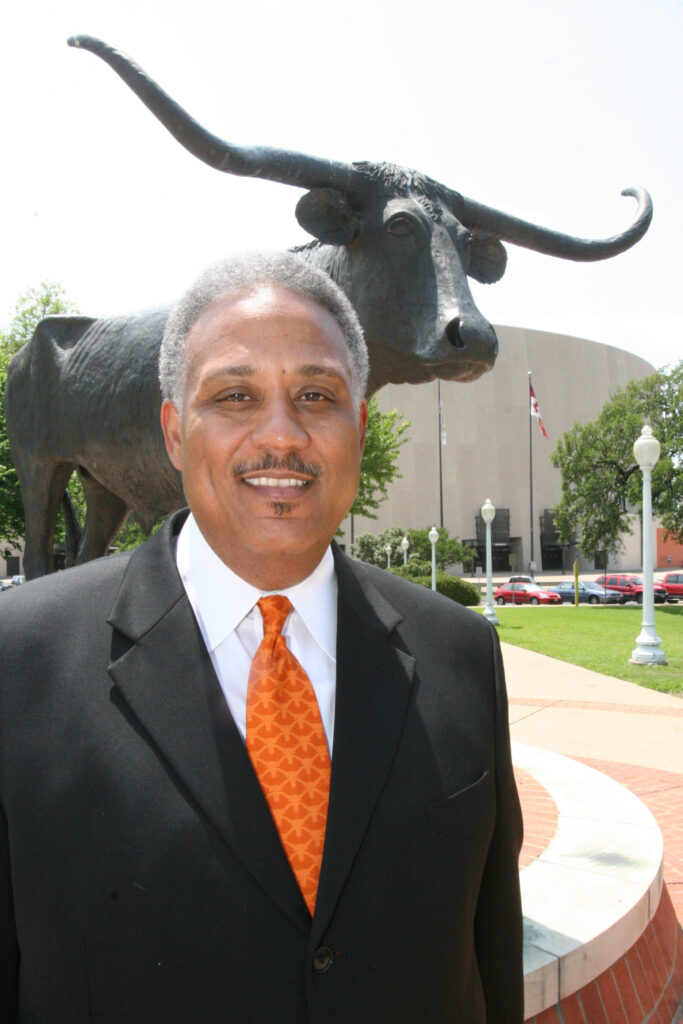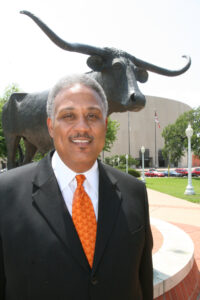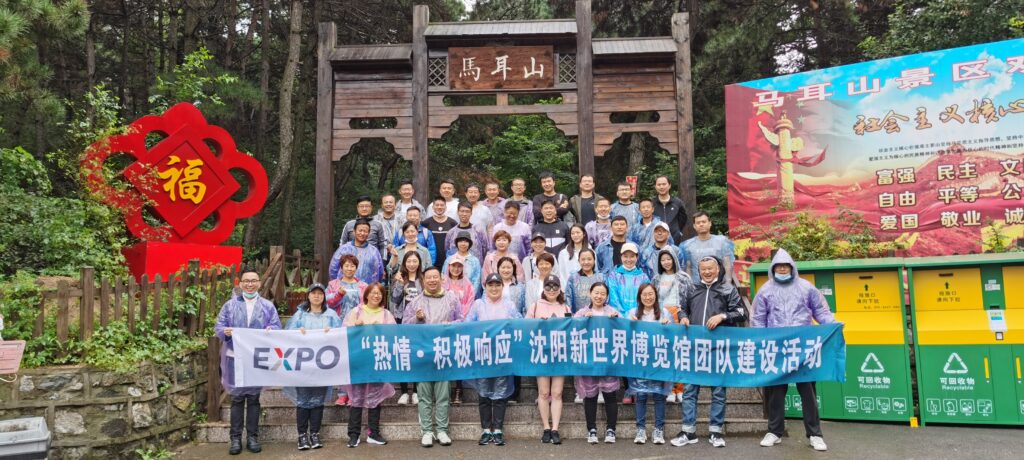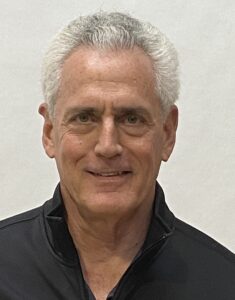Jimmy Earl Retires from University of Texas, But Not Without Years of Fond Memories For Me
By R.V. Baugus
I first met Jimmy Earl, CVE, in the early 2000s when he was going through the chair rotation on the way to becoming the Association’s President (now Chair) in 2004-05. Jimmy was someone I was eager to meet, and in all honesty it was to be able to make the acquaintance of someone who worked at the University of Texas, where I spent one glorious year of my college undergraduate days in 1976-77 when legendary Darrell Royal was coaching in his last season and legendary football icon Earl Campbell was running roughshod his junior year on campus.
I couldn’t wait to talk to Jimmy about all things UT (yeah, yeah, I know, those from Tennessee see this as  blasphemy when it comes to deciding the real UT. Let’s just all get along and say we are both the real UT.). I seem to recall that I might have been more impressed with Jimmy and his oversight at the University’s Frank Erwin Center than he was with me. Or maybe he actually was impressed with this me and I just didn’t know it because of Jimmy’s easy-going, cool, calm, and collected manner. Jimmy always seemed to be the very definition of unruffled when most of the rest of us are running around like our fannies are on fire. Not Jimmy.
blasphemy when it comes to deciding the real UT. Let’s just all get along and say we are both the real UT.). I seem to recall that I might have been more impressed with Jimmy and his oversight at the University’s Frank Erwin Center than he was with me. Or maybe he actually was impressed with this me and I just didn’t know it because of Jimmy’s easy-going, cool, calm, and collected manner. Jimmy always seemed to be the very definition of unruffled when most of the rest of us are running around like our fannies are on fire. Not Jimmy.
Part of me thought that once the discussions about all things UT were over that we would remain professional friends but that in his busy world I was not going to be of much significance to him in later years. Boy, was I wrong.
Today, as news came that after 40 years working tirelessly in this great industry, Senior Associate Athletics Director of the Frank Erwin Center, Jimmy Earl, was unhooking his career and heading into retirement. The news, naturally, gave me great pause to reflect on a working relationship that became a genuine friendship to this very day.
I will always remember sitting with fellow IAVM staff members in 2004 when Jimmy accepted the gavel to lead the association during the annual conference in Washington, D.C. As Jimmy strode onto the stage to the tune of “Duke of Earl,” he accepted the gavel from Mike Kelly, CVE. If I recall, it was before Jimmy made his acceptance remarks that he startled me from the stage by saying, “I’ve got something for R.V. Baugus.” The next thing I know, the University of Texas school song is playing and my fingers instinctively went up in the Hook ‘Em Horns sign.
I will never forget Jimmy for doing that. In one of the biggest moments of his professional career, Jimmy was thinking of me and wanted to do this kind gesture. No, you don’t forget things like that.
It did not take long for me to realize that a friendship was being forged that would go beyond Jimmy being employed at a school I attended.
Interviewing Jimmy in 2004 for his cover story as the incoming president was very memorable. My wife, Tanya, accompanied me on a drive to Austin to visit Jimmy and do the interview. Tanya was multi-talented and handled photography at the interview, including the picture of Jimmy next to the mascot Bevo statue outside the Erwin Center that he liked to use from that day forward and that you see with this article.
Jimmy immediately took to Tanya, and she to him. This would be significant a few years later when Tanya passed away during day surgery at the young age of 48. One of the people I remember talking to the most during my earliest, darkest days was Jimmy, always willing to just listen and be a friend and express his love and support for me. No, you don’t forget things like that.
Tanya and I usually made one trip a year during basketball season to watch the Longhorns play. I always let Jimmy know in advance that we were coming down, and even in the controlled chaos of game day, Jimmy came to our seats before the game with a hug for both of us and to visit before he resumed his work duties. No, you don’t forget things like that.
I remarried a couple of years ago to Charlotte, a blessing from God whom I met in a Grief Share class and whose husband had died two months before my beloved Tanya. It was then Charlotte’s turn to go to games with me, and Jimmy showed Charlotte the same welcoming friendship and attention he always gave Tanya.
Jimmy was very involved most recently in diversity and inclusive initiatives within the association. He was always looking for solutions and not problems, and wanted to make a difference in his beloved IAVM and industry to see these very important initiatives through for the next generations to follow. I never had a deep talk with Jimmy about these issues outside of our Diversity & Inclusive Leadership Committee monthly calls (of which I am the staff liaison), but would love to make another drive to Austin to just hang out and talk about real life and hear it from Jimmy and to try and do my very best to understand it and do what I can to make this a more equitable world to live in.
I would probably also suggest to Jimmy that we head over to Trudy’s in Austin for some Mexican food, just to get a rise out of him telling me, “that’s not real Mexican food. You’ve got to go over to East Austin for real Mexican food.”
A few years ago while at the office, mail arrived in a box for me from Jimmy. I opened the box to reveal a cool UT pullover that I have to this day and am proud to wear. I don’t know why he sent it, but like everything else, the man did it because he wanted to. No, you don’t forget things like that.
Now comes the time when we celebrate, salute, and honor you, “Duke of Earl,” upon your retirement. You are most deserving and have left an example for all of us to follow about how to live, how to love, how to laugh. I am beyond proud to call you a dear personal friend and excited for the next glorious phase of your life, because, well, I am certain it will be something that I won’t soon forget.
Director of the Frank Erwin Center Announces Retirement
Austin, Texas – After over 40 years working in the facility management industry, Senior Associate Athletics Director of the Frank Erwin Center, Jimmy Earl, announced this week that he will retire at the end of September. Earl is only the third director of the Erwin Center since the building’s opening in 1977.
Earl was the first Events Manager of the Erwin Center and has also had experience in large convention complexes, such as the Fort Worth/Tarrant County Convention Center where he was the Manager from 1987 to 1990. Earl completed the Leadership Austin program in 1994, has served with the Austin Arts Commission, the UT Mentor program, Pflugerville Education Foundation (President), Steward Board Metropolitan AME Church, Travis County Amateur Radio Emergency Service (Public Information Officer), Amateur Radio Operator, Extra Class WB5MET and various other boards in Austin.
Earl is a member of Omega Psi Phi Fraternity, Inc., a 1993 graduate of the Public Assembly Facility Management School at Oglebay and attended the Senior Executive Symposium at Cornell in 1997. He has also been an active member of the International Association of Venue Managers (IAVM), the acknowledged leader in public assembly facility management, since 1987.
He has served on several IAVM committees including Convention Centers/Exhibit Halls, Professional Development, Diversity, Arenas, Universities and Publications. Additionally, Earl has served on the IAVM Board as Director-at-Large Universities, Board of Governors Senior Executive Symposium, and the IAVM Foundation as a trustee. In 1995, he attained the Certified Facilities Executive (CFE) designation. He is also a past president of IAVM and in 2016, he was awarded IAVM’s Charles M. McElravy Award, which is given to a Professional, Honorary or Retired member of IAVM, who in the opinion of the Board of Directors has made extraordinary contributions to the Association or the profession of public assembly facility management.
Earl’s colleagues shared the following memories and praise upon hearing about his retirement.
“How could I not love the man who named me the “Moses of Rock ‘N’ Roll”? Jimmy is like that Sade song “Smooth Operator,” no matter what the problem, he always made it go away. He is not only a great building guy, but he’s my friend – I love you Jimmy “Duke Of Earl” – best of luck my friend!” – Louis Messina, CEO, Messina Touring Group, LLC
“The Frank Erwin Center brings special memories to mind, not only because of the wonderful basketball team performances and fan support, but because of the people. The people who supported athletics, entertainment, music and cultural events, that put Austin on the map. Over the decades, I have considered Jimmy Earl a friend and true teammate. He and I shared a passion about increasing diversity on our campus. He spent nearly his entire arena management career at the Erwin Center, rising to the very top level of respect in his profession while the venue emerged as the world’s most productive campus-based multipurpose arena. Jimmy cared about the success of our program no less than that of the biggest rock and roll show staged there. He listened to what mattered to us, and he and his staff worked tirelessly to deliver events in a first-class manner. I will miss our entertaining discussions and banter, from which we always emerged somewhat weary but ready to take on the next exhilarating opportunity to join hands and make our great University a more accessible and embracing place. For that, I’m ever thankful for Jimmy’s service and friendship.” – Jody Conradt, Former UT Women’s Basketball Head Coach (1976-2007), Texas Athletics
“Jimmy Earl has done an outstanding job for The University of Texas for many years. As Senior Associate Athletic Director, he has managed the Erwin Center, which is one of the most complex institutions within The University, with professional style and grace. The University owes Jimmy a great deal of thanks for the support that he has given our scholarship athletes, as well as the many people who have enjoyed a wide variety of events at the Erwin Center.” – Dr. William Cunningham, Former Chancellor (1992-2000), The University of Texas System
Jimmy Earl, CVE, Announces Retirement from Frank Erwin Center
By Anna Wong
After over 40 years working in the facility management industry, Senior Associate Athletics Director of the Frank Erwin Center, Jimmy Earl, CVE, announced that he will retire at the end of September. Earl is only the third director of the Erwin Center since the building’s opening in 1977.
Earl was the first Events Manager of the Erwin Center and has also had experience in large convention complexes,  such as the Fort Worth/Tarrant County Convention Center where he was the Manager from 1987 to 1990. Earl completed the Leadership Austin program in 1994, has served with the Austin Arts Commission, the UT Mentor program, Pflugerville Education Foundation (President), Steward Board Metropolitan AME Church, Travis County Amateur Radio Emergency Service (Public Information Officer), Amateur Radio Operator, Extra Class WB5MET, and various other boards in Austin.
such as the Fort Worth/Tarrant County Convention Center where he was the Manager from 1987 to 1990. Earl completed the Leadership Austin program in 1994, has served with the Austin Arts Commission, the UT Mentor program, Pflugerville Education Foundation (President), Steward Board Metropolitan AME Church, Travis County Amateur Radio Emergency Service (Public Information Officer), Amateur Radio Operator, Extra Class WB5MET, and various other boards in Austin.
Earl is a member of Omega Psi Phi Fraternity, Inc., a 1993 graduate of the Public Assembly Facility Management School at Oglebay and attended the Senior Executive Symposium at Cornell in 1997. He has also been an active member of the International Association of Venue Managers (IAVM), the acknowledged leader in public assembly facility management, since 1987.
He has served on several IAVM committees including Convention Centers/Exhibit Halls, Professional Development, Diversity, Arenas, Universities and Publications. Additionally, Earl has served on the IAVM Board as Director-at-Large Universities, Board of Governors Senior Executive Symposium, and the IAVM Foundation as a trustee. In 1995, he attained the Certified Facilities Executive (CFE) designation. He is also a past president of IAVM and in 2016, he was awarded IAVM’s Charles M. McElravy Award, which is given to a Professional, Honorary or Retired member of IAVM, who in the opinion of the Board of Directors has made extraordinary contributions to the Association or the profession of public assembly facility management.
Earl’s colleagues shared the following memories and praise upon hearing about his retirement.
“How could I not love the man who named me the ‘Moses of Rock ‘N’ Roll’? Jimmy is like that Sade song ‘Smooth Operator,’ no matter what the problem, he always made it go away. He is not only a great building guy, but he’s my friend – I love you Jimmy ‘Duke Of Earl’ – best of luck my friend!” – Louis Messina, CEO, Messina Touring Group, LLC
“The Frank Erwin Center brings special memories to mind, not only because of the wonderful basketball team performances and fan support, but because of the people. The people who supported athletics, entertainment, music and cultural events, that put Austin on the map. Over the decades, I have considered Jimmy Earl a friend and true teammate. He and I shared a passion about increasing diversity on our campus. He spent nearly his entire arena management career at the Erwin Center, rising to the very top level of respect in his profession while the venue emerged as the world’s most productive campus-based multipurpose arena. Jimmy cared about the success of our program no less than that of the biggest rock and roll show staged there. He listened to what mattered to us, and he and his staff worked tirelessly to deliver events in a first-class manner. I will miss our entertaining discussions and banter, from which we always emerged somewhat weary but ready to take on the next exhilarating opportunity to join hands and make our great University a more accessible and embracing place. For that, I’m ever thankful for Jimmy’s service and friendship.” – Jody Conradt, Former UT Women’s Basketball Head Coach (1976-2007), Texas Athletics
“Jimmy Earl has done an outstanding job for The University of Texas for many years. As Senior Associate Athletic Director, he has managed the Erwin Center, which is one of the most complex institutions within The University, with professional style and grace. The University owes Jimmy a great deal of thanks for the support that he has given our scholarship athletes, as well as the many people who have enjoyed a wide variety of events at the Erwin Center.” – Dr. William Cunningham, Former Chancellor (1992-2000), The University of Texas System
Anna Wong is Assistant Director, Marketing and Sales at Frank Erwin Center.
Shenyang New World EXPO Celebrates at September 4 Staff Retreat
Shenyang New World EXPO staff held its annual staff retreat on September 4. There has been an annual staff leadership retreat each year since the venue began hiring staff in 2016.
Pictured: Shenyang New World EXPO staff was all smiles at its annual leadership retreat on September 4. The  theme of this year’s team building activity was “Enthusiasm and responsiveness,” which is a fundamental part of the staff’s mission and customer care practices. The team is led by General Manager Diane CHEN and Deputy GM Jack CHENG (front row, 5th and 4th from the left, respectively). Cliff Wallace, CVE, Chairman of EXPO (2009-2018), is the Senior Executive Advisor to the EXPO team. The venue reopened on July 30 following closure on January 27 due to the COVID-19 outbreak.
theme of this year’s team building activity was “Enthusiasm and responsiveness,” which is a fundamental part of the staff’s mission and customer care practices. The team is led by General Manager Diane CHEN and Deputy GM Jack CHENG (front row, 5th and 4th from the left, respectively). Cliff Wallace, CVE, Chairman of EXPO (2009-2018), is the Senior Executive Advisor to the EXPO team. The venue reopened on July 30 following closure on January 27 due to the COVID-19 outbreak.
Industry Veteran Chuck Rogers Joins BioSaphe
Don Clark, CEO of Provo, Utah-based BioSaphe, announced that industry veteran Chuck Rogers is now a member of the
BioSaphe team.
“Chuck has a unique combination of knowing both sides of the business,” Clark said. “He will bring a wealth of
business acumen to our operation. Given his track record and enthusiasm, we look forward to his contribution as the newest member of our Business Development team.”
Rogers joins BioSaphe and carries on a distinguished career in the public assembly venue industry spanning nearly 40 years. During that time, he has sold and managed sales teams providing solutions from capital equipment to managed services from concessions to cleaning, security staffing, stages, and scoreboards.
Rogers is well known as an advocate of high levels of customer service, and has served on numerous committees for IAVM, as well as on the Board of Directors and as a Venue Management School Co-Class President. He currently serves on the Region 6 Board of Directors.
“I am thrilled and honored to join the BioSaphe team,” Rogers said. “This opportunity allows me to pursue a long-time passion for our industry, help facilities save valuable natural resources, and improve their playing surfaces. The incredible team Don has assembled is ready to grow and I am honored to play a role in that effort.”
The MIC Coalition Adds Three New Members Representing the Exhibition and Events Industry
By MIC Coalition
The MIC Coalition, a broad-based group of associations representing millions of restaurants, bars, hotels, wineries, breweries, local radio and television broadcasters, digital music services, retailers and other venues that bring music to consumers, announced the addition of three major organizations representing the exhibition and events industry.
International Association of Exhibitions and Events (IAEE), Meeting Professionals International (MPI), and  Society of Independent Show Organizers (SISO) join the MIC Coalition’s robust membership, representing the trade show, meeting and event industry in the Coalition’s shared mission to create a more sustainable and transparent music licensing system to drive the future of music. IAVM is proud to be a member of the Coalition.
Society of Independent Show Organizers (SISO) join the MIC Coalition’s robust membership, representing the trade show, meeting and event industry in the Coalition’s shared mission to create a more sustainable and transparent music licensing system to drive the future of music. IAVM is proud to be a member of the Coalition.
The expansion of MIC’s membership comes on the heels of a public workshop hosted by the Department of Justice which explored the importance of the ASCAP and BMI consent decrees. During the workshop, voices representing the U.S. hospitality industry and events and meeting industry were largely underrepresented. As these industries continue to experience financial strain as a result of the current outbreak of COVID-19, IAEE, MPI and SISO are dedicated to ensuring the voices of their members are heard by policymakers and regulators in Washington.
The new Coalition members commented:
“For decades, trade shows around the world have been instrumental to building brands, forging partnerships, providing education and so much more. Securing music licenses is a key process in making these events successful. As our industry begins to rebuild, we look forward to working with the MIC Coalition and bringing the stories of our members to policymakers and regulators. Now, more than ever, it is critical our members are protected from anticompetitive practices to ensure a fair and transparent music licensing ecosystem,” said David DuBois, CMP, CAE, FASAE, CTA, President and CEO, International Association of Exhibitions and Events (IAEE).
“The meetings and events industry has been devastated by recent cancellations of conferences, sporting events, and large gatherings. As our community prepares to host events again, once it is safe to do so, it is critical that they retain the ability to play music and pay for music licenses. Modification or termination of the existing structure will only act to undermine and further delay the progress that has been made towards creating a fair and transparent music licensing system. This system is critical to keeping our industry strong and we look forward to working with the MIC Coalition to ensure members like ours are given the same pro-competitive protections that have been provided for decades,” said Paul Van Deventer, President and CEO, Meeting Professionals International (MPI).
“Our members, who include companies, corporations and other for-profit entities that own, produce or provide full-service management of ‘face to face’ trade shows, consumer shows, expositions, conferences and similar events rely on music to make their events positive, well-rounded experiences for attendees. While the music licensing system is not perfect, we look forward to joining MIC Coalition in making the ecosystem a place where SISO’s members are able to secure licenses in a fair way,” said David Audrain, Executive Director, Society of Independent Show Organizers (SISO).
Do you want to receive a Front Row News weekly digest?
Categories
- Allied (861)
- Architecture (147)
- Arenas (747)
- Career (897)
- Convention Centers (895)
- Education (623)
- Events (1,544)
- Food & Beverage (193)
- Foundation (113)
- Guest Experience (1,496)
- Industry News (2,270)
- Leadership (1,888)
- Marketing (150)
- Membership (2,000)
- Music (213)
- Performing Arts Centers (454)
- Professional Development (409)
- Research (127)
- Safety & Security (442)
- Sports (763)
- Stadiums (608)
- Student (159)
- Technology (516)
- Ticketing (92)
- Touring (82)
- Trends (364)
- Uncategorized (741)
- Universities (218)
- Video (25)
- Young Professional (198)
Twitter Feed
- Twitter feed loading
Recent Posts
- Peggy Daidakis Humbly Made Convention Center History
- Welcome to Our Newest Members
- New Member Benefit! IAVM Partners with Advantage Training to Elevate Staff Readiness and Guest Experience
- Charlotte Convention Center Welcomes Two New Leaders to its Management Team
- Fort Worth Cuts Ribbon on Phase 1 of Convention Center Expansion
Categories
- Allied
- Architecture
- Arenas
- Career
- Convention Centers
- Education
- Events
- Food & Beverage
- Foundation
- Guest Experience
- Industry News
- Leadership
- Marketing
- Membership
- Music
- Performing Arts Centers
- Professional Development
- Research
- Safety & Security
- Sports
- Stadiums
- Student
- Technology
- Ticketing
- Touring
- Trends
- Uncategorized
- Universities
- Video
- Young Professional
Archives
- December 2025
- November 2025
- October 2025
- September 2025
- August 2025
- July 2025
- June 2025
- May 2025
- April 2025
- March 2025
- February 2025
- January 2025
- December 2024
- November 2024
- October 2024
- September 2024
- August 2024
- July 2024
- June 2024
- May 2024
- April 2024
- March 2024
- February 2024
- January 2024
- December 2023
- November 2023
- October 2023
- September 2023
- August 2023
- July 2023
- June 2023
- May 2023
- April 2023
- March 2023
- February 2023
- January 2023
- December 2022
- November 2022
- October 2022
- September 2022
- August 2022
- July 2022
- June 2022
- May 2022
- April 2022
- March 2022
- February 2022
- January 2022
- December 2021
- November 2021
- October 2021
- September 2021
- August 2021
- July 2021
- June 2021
- May 2021
- April 2021
- March 2021
- February 2021
- January 2021
- December 2020
- November 2020
- October 2020
- September 2020
- August 2020
- July 2020
- June 2020
- May 2020
- April 2020
- March 2020
- February 2020
- January 2020
- December 2019
- November 2019
- October 2019
- September 2019
- August 2019
- July 2019
- June 2019
- May 2019
- April 2019
- March 2019
- February 2019
- January 2019
- December 2018
- November 2018
- October 2018
- September 2018
- August 2018
- July 2018
- June 2018
- May 2018
- April 2018
- March 2018
- February 2018
- January 2018
- December 2017
- November 2017
- October 2017
- September 2017
- August 2017
- July 2017
- June 2017
- May 2017
- April 2017
- March 2017
- February 2017
- January 2017
- December 2016
- November 2016
- October 2016
- September 2016
- August 2016
- July 2016
- June 2016
- May 2016
- April 2016
- March 2016
- February 2016
- January 2016
- December 2015
- November 2015
- October 2015
- September 2015
- August 2015
- July 2015
- June 2015
- May 2015
- April 2015
- March 2015
- February 2015
- January 2015
- December 2014
- November 2014
- October 2014
- September 2014
- August 2014
- July 2014
- June 2014
- May 2014
- April 2014
- March 2014
- February 2014
- January 2014
- December 2013
- November 2013
- October 2013
- September 2013
- August 2013
- July 2013
- June 2013
- May 2013
- April 2013
- March 2013
- February 2013
- January 2013
- May 2012
- March 2012
- December 2011
- November 2011
- October 2011
Recent Comments
- Frank Bradshaw, Ph.D., CVE on John Meyer, CVE, a Tireless Advocate of Certification for Venue Professionals, Has Died
- Neil Sulkes on Hilary Hartung, Friend to Many in Venue Marketing, Has Left Us
- Jason Parker, CVE on The Devastation of Hurricane Helene and How We Can Support One Another
- Larry Perkins on Touhey Testifies Against Speculative Ticketing Before Congressional Subcommittee
- Peter Secord on Major Players for Planned Elkhart Amphitheater Were in the Mix at VenueConnect
